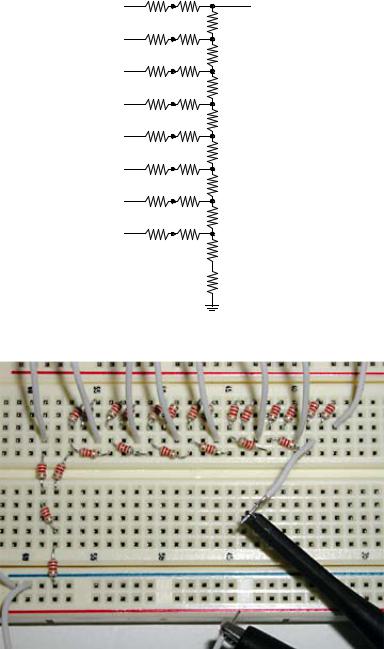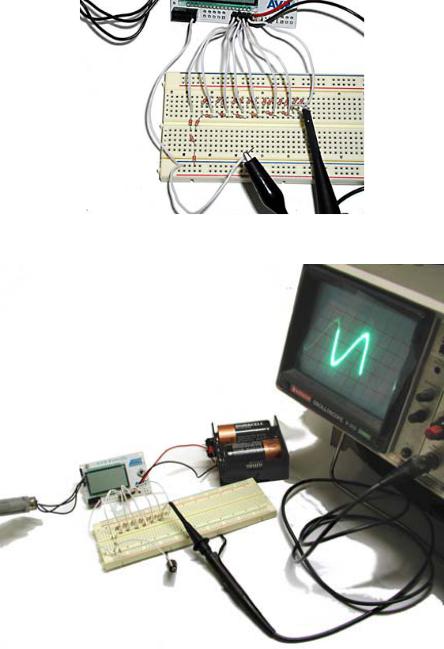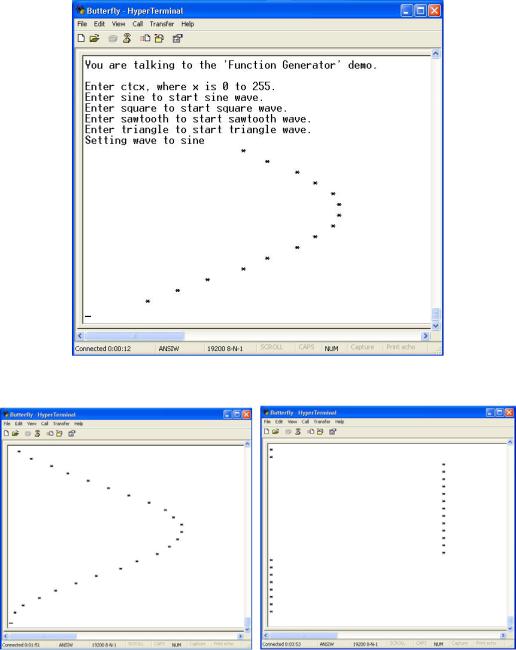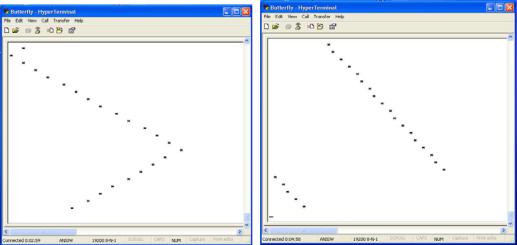
- •Chapter 1: Introduction
- •Goals
- •Chapter 2: Quick Start Guide
- •Software
- •WinAVR – Oh, Whenever…
- •Programmers Notepad
- •AVRStudio – FREE and darn well worth it.
- •Br@y++ Terminal:
- •Hardware
- •Constructing Your Development Platform
- •Blinking LEDs – Your First C Program
- •Write it in Programmers Notepad
- •Download to the Butterfly with AVRStudio
- •Blinky Goes Live
- •Simulation with AVRStudio
- •GOOD GRIEF!
- •Comments
- •Include Files
- •Expressions, Statements, and Blocks
- •Operators
- •Flow Control
- •Functions
- •The Main() Thing
- •Chapter 4: C Types, Operators, and Expressions
- •Data Types and Sizes
- •Seen on a shirt at a Robothon event:
- •Bits
- •Bytes
- •The long and short of it
- •Variable Names
- •Constants
- •Declarations
- •Arithmetic Operators
- •Relational and Logical Operators
- •Bitwise Operators
- •Testing Bits
- •Assignment Operators and Expressions
- •Conditional Expressions
- •Precedence and Order of Evaluation
- •Projects
- •Port Input and Output
- •Cylon Eye Speed and Polarity Control
- •Chapter 5: C Control Flow
- •Statements and Blocks
- •If-Else and Else-If
- •Switch
- •Loops – While, For and Do-while
- •Break and Continue
- •Goto and Labels
- •A few practical examples: strlen, atoi, itoa, reverse
- •Chapter 6: C Functions and Program Structures
- •Function Basics
- •Returns
- •Variables External, Static, and Register
- •Scope
- •Headers
- •Blocks
- •Initialization
- •Recursion
- •Preprocessor
- •Macro Substitution
- •Conditional Inclusion
- •Projects
- •Is anybody out there? Communicating with a PC
- •Demonstrator
- •PC_Comm
- •Using CommDemo:
- •Chapter 7: Microcontroller Interrupts and Timers
- •Interrupts
- •Projects
- •Grab your joystick – and test your interrupts
- •Using joystick
- •Timers/Counters
- •Calibrating the Butterfly oscillator:
- •OSCCAL_calibration() function – detailed explanation
- •ALL THIS AND WE HAVEN’T EVEN STARTED CALIBRATING YET!
- •Projects
- •Precision Blinking
- •Using Precision Blinking:
- •Pulse Width Modulation – LED Brightness Control
- •Pulse Width Modulation - Motor Speed Control
- •Speedometer
- •Chapter 8: C Pointers and Arrays
- •Addresses of variables
- •Function Arguments
- •Arrays
- •FIFOs and LIFOs: Stacks and Queues (Circular Buffers)
- •Stacks
- •Queues (Circular Buffers)
- •Function Pointers
- •Complex Pointer and Array Algorithms
- •Projects
- •Messenger
- •Arrays in RAM and ROM
- •Does anybody know what time it is? A Real Time Clock.
- •A one second interrupt
- •Converting Computer Time to Human Readable Time
- •The Real Timer Clock Software
- •Music to my ears. “Play it again Sam.”
- •More on pointers to arrays
- •Setting the frequency
- •Setting the duration
- •An example song array – Fur Elise
- •Using the Piezo-element to make sound
- •Initializing the Timer1 for PWM to the piezo-element.
- •Generating the tone using PWM from Timer1
- •Using the Timer0 interrupt to play a tune
- •Chapter 9 – Digital Meets Analog – ADC and DAC
- •But First - A Debugging Tale
- •Analog to Digital Conversion
- •What is Analog to Digital Conversion?
- •Analog to Digital Conversion by Successive Approximation
- •Analog to Digital Conversion with the ATMEGA169
- •Starting a Conversion
- •Conversion Timing
- •Changing Channels
- •Digital Noise Reduction
- •Conditioning the Analog Input Signal
- •Accuracy
- •Projects
- •Initializing the ADC
- •Reading the ADC
- •Light Meter
- •Temperature Meter
- •The @#%#&*#!!!! Volt Meter
- •Using ADC
- •DAC and ADC - Function Generator / Digital Oscilloscope
- •Chapter 10: C Structures
- •Structure Basics
- •Structures and Functions
- •Structure Arrays
- •Typedef
- •Unions
- •Bit-fields
- •Bit-Fields the C-way
- •Bit-fields the masking-way
- •Projects
- •Finite State Machine
- •Chapter 11 The Butterfly LCD
- •PC to LCD test program
- •Conclusion
- •Appendix 1: Project Kits
- •Data I/O
- •PWM Motor Control
- •Appendix 2: Soldering Tutorial
- •Appendix 3: Debugging Tale
- •Appendix 4: ASCII Table
- •Appendix 5: Decimal, Hexadecimal, and Binary
- •Appendix 6: Motor Speed Control Wheel
- •Appendix 7: HyperTerminal
- •Index
Chapter 9 – Digital Meets Analog – ADC and DAC
DAC and ADC - Function Generator / Digital Oscilloscope
In this project we will use a Digital to Analog Converter, DAC, made with a R-2R resistor ladder circuit that will output voltages from 0 to +3v in 255 steps. We will use voltage values stored in look-up tables to generate ‘functions’ which in this case are repeating wave forms: sine, square, triangle, and sawtooth. Since this is an educational enterprise we will reuse the software with the millisecond interrupt making our ‘wave’ frequencies pretty slow.
We will also develop a Digital Oscilloscope, using the Butterfly’s ADC and reusing the ADC project software to read the data from our Function Generator. Since Digital Oscilloscopes normally cost tens of thousands of dollars, you can expect some compromises. This thing is very very very … very slow. (And the ‘screen’ is rotated 90 degrees.) If you set the ‘ctc’ to 250 you can see the wave output on HyperTerminal. If you set ‘ctc’ to 1, you can see the signal on a real oscilloscope.
We will output the look-up table data on port D and attach the pins as shown in Figure 27. An R-2R resistor ladder looks a little magical, and the circuit analysis, though simple in concept, turns out to be fairly complex, but it makes a reasonably accurate DAC for very little cost. Usually you’ll see two resistor values in this type circuit, in our case we would use a single 4.4k Ohm resistor in place of the two 2.2k resistors, but since we got 100 2.2k resistors from our JAMECO list, Let’s just use two of each for the 4.4k resistors. The 2.2k and 4.4k are not magical numbers; you can use any value for R as long as the other is 2R and not be so low as to drain the battery or so high as to block the current.
Using the 2.2k resistors from the JAMECO list construct your DAC using the schematic in Figure 27, which is illustrated by the close-up photo in Figure 28, a medium distant photo in Figure 29, and the full setup in Figure 30 complete with a sine wave on an oscilloscope.
If you don’t have an oscilloscope, just connect the output of the DAC to the Butterfly ADC on J407, just like with the potentiometer as shown in Figure 29. Now you can read the output using HyperTerminal and have a really slow crappy sideways oscilloscope as shown in Figure 34.
227

Chapter 9 – Digital Meets Analog – ADC and DAC
PORTD.7 |
|
Analog Out |
2.2 k |
2.2 k |
2.2 k |
PORTD.6 |
|
|
2.2 k |
2.2 k |
2.2 k |
PORTD.5 |
|
|
2.2 k |
2.2 k |
2.2 k |
PORTD.4 |
|
|
2.2 k |
2.2 k |
2.2 k |
PORTD.3 |
|
|
2.2 k |
2.2 k |
2.2 k |
PORTD.2 |
|
|
2.2 k |
2.2 k |
2.2 k |
PORTD.1 |
|
|
2.2 k |
2.2 k |
2.2 k |
PORTD.0 |
|
|
2.2 k |
2.2 k |
2.2 k |
|
|
2.2 k |
Figure 30: R-2R resistor ladder
Figure 31: Breadboard of R-2R DAC
228

Chapter 9 – Digital Meets Analog – ADC and DAC
Figure 32: Breadboard R-2R DAC wiring
Figure 33: R-2R DAC with Oscilloscope
229

Chapter 9 – Digital Meets Analog – ADC and DAC
Figure 34: Function Generator / Digital Oscilloscope on HyperTerminal
230

Chapter 9 – Digital Meets Analog – ADC and DAC
Figure 35: Sine Wave |
Figure 36: Square Wave |
Figure 37: Triangle Wave |
Figure 38: Sawtooth Wave |
Your skills as a C programmer should be to the point where you can read and understand all the software for this project without further comment. So I’ll just give you the listing and let you have at it.
// Demonstrator.h Function Generator / Digital Oscilloscope version
void initializer(void); void parseInput(char *); void showMessage(char);
int parse_ctc(char *); void set_ctc(int);
void startWave(int); void startSine(void); void startSquare(void);
void startSawtooth(void); void startTriangle(void);
void DigitalOscilloscopeTimerInit(void);
void MilliSec_init(unsigned char count); void set_OCR0A(unsigned char count);
void ADC_init(void); int ADC_read(void);
231
Chapter 9 – Digital Meets Analog – ADC and DAC
// Demonstrator.c Function Generator / Digital Oscilloscope version
#include "PC_Comm.h" #include "Messages.h" #include "WaveTables.h"
unsigned char count = 0; unsigned char tenth = 0;
//unsigned long signal = 0; // used for test
void initializer()
{
//Calibrate the oscillator: OSCCAL_calibration();
//Initialize the USART USARTinit();
//set PORTD for output
DDRD = 0xFF;
// Display instructions on PC sendFString(TALKING_TO); sendFString(WHO_DEMO);
sendFString(ENTER); sendFString(TEXT_CTC);
sendFString(ENTER); sendFString(TEXT_SINE); sendFString(TO_START); sendFString(TEXT_SINE); sendFString(WAVE);
sendFString(ENTER); sendFString(TEXT_SQUARE); sendFString(TO_START); sendFString(TEXT_SQUARE); sendFString(WAVE);
sendFString(ENTER); sendFString(TEXT_SAWTOOTH); sendFString(TO_START); sendFString(TEXT_SAWTOOTH); sendFString(WAVE);
sendFString(ENTER); sendFString(TEXT_TRIANGLE); sendFString(TO_START); sendFString(TEXT_TRIANGLE); sendFString(WAVE);
MilliSec_init(250); // default to 1000 Hz
DigitalOscilloscopeTimerInit();
232
Chapter 9 – Digital Meets Analog – ADC and DAC
ADC_init();
startSine();
}
void parseInput(char s[])
{
// parse first character switch (s[0])
{
case 's':
if( (s[1] == 'i') && (s[2] == 'n')&& (s[3] == 'e')) startSine();
else if((s[1]=='q')&&(s[2]=='u')&&(s[3]=='a')&&(s[4]=='r')&&(s[5]=='e')) startSquare();
else if((s[1]=='a')&&(s[2]=='w'&&(s[3]=='t')&&(s[4]=='o')&&(s[5]=='o') &&(s[6]=='t')&&(s[7]=='h'))
startSawtooth();
break;
case't':
if((s[1]=='r')&&(s[2]=='i')&&(s[3]=='a')&&(s[4]=='n')&&(s[5]=='g')&&(s[6]=
='l')&&(s[7]=='e'))
startTriangle();
break;
case 'c':
if( (s[1] == 't') && (s[2] == 'c')) parse_ctc(s);
break;
case 'd':
if( (s[1] == 'e') && (s[2] == 'm') && (s[3] == 'o') && (s[4] == '?') ) sendFString(TALKING_TO);
sendFString(WHO_DEMO); break;
default:
sendFString(BAD_COMMAND1); sendChar(s[0]); sendFString(BAD_COMMAND2);
break;
}
s[0] = '\0';
}
int parse_ctc(char s[])
{
char ctc[11];
unsigned char i = 3, j = 0;
while( (s[i] != '\0') && (j <= 11) )
{
if( (s[i] >= '0') && (s[i] <= '9') )
{
ctc[j++] = s[i++];
}
else
233
Chapter 9 – Digital Meets Analog – ADC and DAC
{
sendFString(ERROR_NONINT); sendChar(s[i]); sendChar('\r');
return 0;
}
}
ctc[j] = '\0';
if(j>4)// must be < 256
{
sendFString(ERROR_NUMTOLARGE); return 0;
}
else
{
set_ctc(atoi(ctc));
}
return 1;
}
void set_ctc(int count)
{
char ctc[11];
sendString("Setting the Compare Timer Count to: "); itoa(count,ctc,10);
sendString(ctc);
sendChar('\r');
MilliSec_init(count);
}
void startWave(int wave)
{
sendFString(TEXT_SETTING);
sendFString(TEXT_WAVE_TBL[wave]); // Send the song title to the PC sendChar('\r');
pWave=(int*)pgm_read_word(&Waves[wave]); // looks too complicated..
}
void startSine()
{
startWave(0);
}
void startSquare()
{
startWave(1);
}
void startSawtooth()
{
startWave(2);
}
234
Chapter 9 – Digital Meets Analog – ADC and DAC
void startTriangle()
{
startWave(3);
}
/*
The USART init set the system oscillator to 2 mHz. We set the Timer0 prescaler
to clk/8 which gives a 250 kHz input to the timer/counter. A compare of 250 throws an interrupt every millisecond.
*/
void MilliSec_init(unsigned char count)
{
//Initialize Timer0.
//Enable timer0 compare interrupt TIMSK0 = (1<<OCIE0A);
//Sets the compare value
set_OCR0A(count);
// Set Clear on Timer Compare (CTC) mode,
TCCR0A = (1<<WGM01)|(0<<WGM00)|(1<<CS02)|(0<<CS01)|(0<<CS00);
}
// Initialize for 1 millisecond interrupt void DigitalOscilloscopeTimerInit()
{
//Initialize Timer2.
//Enable timer2 compare interrupt TIMSK2 = (1<<OCIE2A);
//Sets the compare value OCR2A = 1;
//Set Clear on Timer Compare (CTC) mode,
TCCR2A = (1<<WGM21)|(0<<WGM20)|(1<<CS22)|(0<<CS21)|(0<<CS20);
}
void set_OCR0A(unsigned char count)
{
// Sets the compare value OCR0A = count;
}
//Interrupt occurs once per millisecond SIGNAL(SIG_OUTPUT_COMPARE0)
{
//signal += pgm_read_word(pWave + count); // used for test
PORTD = pgm_read_word(pWave + count++); |
// read table |
tenth++; |
|
}
235
Chapter 9 – Digital Meets Analog – ADC and DAC
// Interrupt occurs once per millisecond SIGNAL(SIG_OUTPUT_COMPARE2)
{
|
int sig = 0; |
|
sig = ADC_read(); |
|
if (tenth >= 10) |
|
{ |
|
tenth = 0; |
|
for(int i = 0; i < (sig/4); i++) |
|
{ |
|
sendChar(' '); |
|
} |
|
sendChar('*'); |
|
sendChar('\r'); |
|
} |
/* |
// Test code to output wave from table to HyperTerminal |
|
if (tenth >= 10) |
|
{ |
|
tenth = 0; |
|
signal /= 50; |
|
for(int i = 0; i < signal; i++) |
|
{ |
|
sendChar(' '); |
|
} |
|
sendChar('*'); |
|
sendChar('\r'); |
|
signal = 0; |
*/ |
} |
|
|
} |
|
/*********************************************************************************
*
ADC common functions
**********************************************************************************
*/
void ADC_init()
{
int dummy = 0;
ADMUX = 1;
//set ADC prescaler to , 1MHz / 8 = 125kHz ADCSRA = (1<<ADEN) | (1<<ADPS1) | (1<<ADPS0);
//Take a dummy reading , which basically allows the ADC
//to hack up any hairballs before we take any real readings dummy = ADC_read();
236
Chapter 9 – Digital Meets Analog – ADC and DAC
}
int ADC_read(void)
{
char i;
int ADC_temp;
// mt int ADC = 0 ; int ADCr = 0;
// To save power, the voltage over the LDR and the NTC is turned off when not
used |
|
|
|
|
|
|
|
|
// This is done by controlling the voltage from a I/O-pin (PORTF3) |
VCP |
(VC- |
||||||
sbi(PORTF, PF3); // mt sbi(PORTF, PORTF3); |
// Enable the |
|||||||
peripheral) |
|
|
|
|
|
|
|
|
sbi(DDRF, DDF3); // sbi(DDRF, PORTF3); |
|
|
|
|
|
|||
sbi(ADCSRA, ADEN); |
// Enable the ADC |
|
|
|
|
|
||
//do a dummy readout first |
// do single conversion |
|
|
|
||||
ADCSRA |= (1<<ADSC); |
|
|
|
|
||||
while(!(ADCSRA & 0x10)); |
// wait for conversion done, ADIF flag active |
|
||||||
for(i=0;i<8;i++) |
|
// |
do the |
ADC |
conversion |
8 times |
for better |
|
accuracy |
|
|
|
|
|
|
|
|
{ |
|
// do single conversion |
|
|
|
|||
ADCSRA |= (1<<ADSC); |
|
|
|
|||||
while(!(ADCSRA & 0x10)); |
// wait for conversion done, ADIF flag active |
|||||||
ADC_temp = ADCL; |
|
// read out ADCL register |
|
|
|
|||
ADC_temp += (ADCH << 8); |
// read out ADCH register |
|
|
|
||||
ADCr += ADC_temp; |
// |
accumulate |
result (8 |
samples) |
for |
later |
||
averaging |
|
|
|
|
|
|
|
|
} |
|
|
|
|
|
|
|
|
ADCr = ADCr >> 3; |
// average the 8 samples |
|
|
|
|
|||
cbi(PORTF,PF3); // mt cbi(PORTF, PORTF3); |
// disable the VCP |
|
|
|||||
cbi(DDRF,DDF3); // mt cbi(DDRF, PORTF3); |
|
|
|
|
|
|||
cbi(ADCSRA, ADEN); |
// disable the ADC |
|
|
|
|
|
||
return ADCr; |
|
|
|
|
|
|
|
|
} |
|
|
|
|
|
|
|
|
// WaveTables.h
const int Sine[] PROGMEM =
{
0x80,0x83,0x86,0x89,0x8c,0x8f,0x92,0x95,0x98,0x9c,0x9f,0xa2,0xa5,0xa8,0xab,0xae,
0xb0,0xb3,0xb6,0xb9,0xbc,0xbf,0xc1,0xc4,0xc7,0xc9,0xcc,0xce,0xd1,0xd3,0xd5,0xd8,
0xda,0xdc,0xde,0xe0,0xe2,0xe4,0xe6,0xe8,0xea,0xec,0xed,0xef,0xf0,0xf2,0xf3,0xf5,
0xf6,0xf7,0xf8,0xf9,0xfa,0xfb,0xfc,0xfc,0xfd,0xfe,0xfe,0xff,0xff,0xff,0xff,0xff,
0xff,0xff,0xff,0xff,0xff,0xff,0xfe,0xfe,0xfd,0xfc,0xfc,0xfb,0xfa,0xf9,0xf8,0xf7,
0xf6,0xf5,0xf3,0xf2,0xf0,0xef,0xed,0xec,0xea,0xe8,0xe6,0xe4,0xe2,0xe0,0xde,0xdc,
0xda,0xd8,0xd5,0xd3,0xd1,0xce,0xcc,0xc9,0xc7,0xc4,0xc1,0xbf,0xbc,0xb9,0xb6,0xb3,
0xb0,0xae,0xab,0xa8,0xa5,0xa2,0x9f,0x9c,0x98,0x95,0x92,0x8f,0x8c,0x89,0x86,0x83,
237
Chapter 9 – Digital Meets Analog – ADC and DAC
0x80,0x7c,0x79,0x76,0x73,0x70,0x6d,0x6a,0x67,0x63,0x60,0x5d,0x5a,0x57,0x54,0x51,
0x4f,0x4c,0x49,0x46,0x43,0x40,0x3e,0x3b,0x38,0x36,0x33,0x31,0x2e,0x2c,0x2a,0x27,
0x25,0x23,0x21,0x1f,0x1d,0x1b,0x19,0x17,0x15,0x13,0x12,0x10,0x0f,0x0d,0x0c,0x0a,
0x09,0x08,0x07,0x06,0x05,0x04,0x03,0x03,0x02,0x01,0x01,0x00,0x00,0x00,0x00,0x00,
0x00,0x00,0x00,0x00,0x00,0x00,0x01,0x01,0x02,0x03,0x03,0x04,0x05,0x06,0x07,0x08,
0x09,0x0a,0x0c,0x0d,0x0f,0x10,0x12,0x13,0x15,0x17,0x19,0x1b,0x1d,0x1f,0x21,0x23,
0x25,0x27,0x2a,0x2c,0x2e,0x31,0x33,0x36,0x38,0x3b,0x3e,0x40,0x43,0x46,0x49,0x4c,
0x4f,0x51,0x54,0x57,0x5a,0x5d,0x60,0x63,0x67,0x6a,0x6d,0x70,0x73,0x76,0x79,0x7c
};
const int Square[] PROGMEM =
{
0x00,0x00,0x00,0x00,0x00,0x00,0x00,0x00,0x00,0x00,0x00,0x00,0x00,0x00,0x00,0x00,
0x00,0x00,0x00,0x00,0x00,0x00,0x00,0x00,0x00,0x00,0x00,0x00,0x00,0x00,0x00,0x00,
0x00,0x00,0x00,0x00,0x00,0x00,0x00,0x00,0x00,0x00,0x00,0x00,0x00,0x00,0x00,0x00,
0x00,0x00,0x00,0x00,0x00,0x00,0x00,0x00,0x00,0x00,0x00,0x00,0x00,0x00,0x00,0x00,
0x00,0x00,0x00,0x00,0x00,0x00,0x00,0x00,0x00,0x00,0x00,0x00,0x00,0x00,0x00,0x00,
0x00,0x00,0x00,0x00,0x00,0x00,0x00,0x00,0x00,0x00,0x00,0x00,0x00,0x00,0x00,0x00,
0x00,0x00,0x00,0x00,0x00,0x00,0x00,0x00,0x00,0x00,0x00,0x00,0x00,0x00,0x00,0x00,
0x00,0x00,0x00,0x00,0x00,0x00,0x00,0x00,0x00,0x00,0x00,0x00,0x00,0x00,0x00,0x00,
0xff,0xff,0xff,0xff,0xff,0xff,0xff,0xff,0xff,0xff,0xff,0xff,0xff,0xff,0xff,0xff,
0xff,0xff,0xff,0xff,0xff,0xff,0xff,0xff,0xff,0xff,0xff,0xff,0xff,0xff,0xff,0xff,
0xff,0xff,0xff,0xff,0xff,0xff,0xff,0xff,0xff,0xff,0xff,0xff,0xff,0xff,0xff,0xff,
0xff,0xff,0xff,0xff,0xff,0xff,0xff,0xff,0xff,0xff,0xff,0xff,0xff,0xff,0xff,0xff,
0xff,0xff,0xff,0xff,0xff,0xff,0xff,0xff,0xff,0xff,0xff,0xff,0xff,0xff,0xff,0xff,
0xff,0xff,0xff,0xff,0xff,0xff,0xff,0xff,0xff,0xff,0xff,0xff,0xff,0xff,0xff,0xff,
0xff,0xff,0xff,0xff,0xff,0xff,0xff,0xff,0xff,0xff,0xff,0xff,0xff,0xff,0xff,0xff,
0xff,0xff,0xff,0xff,0xff,0xff,0xff,0xff,0xff,0xff,0xff,0xff,0xff,0xff,0xff,0xff
};
const int Sawtooth[] PROGMEM =
{
0x00,0x01,0x02,0x03,0x04,0x05,0x06,0x07,0x08,0x09,0x0a,0x0b,0x0c,0x0d,0x0e,0x0f,
0x10,0x11,0x12,0x13,0x14,0x15,0x16,0x17,0x18,0x19,0x1a,0x1b,0x1c,0x1d,0x1e,0x1f,
0x20,0x21,0x22,0x23,0x24,0x25,0x26,0x27,0x28,0x29,0x2a,0x2b,0x2c,0x2d,0x2e,0x2f,
0x30,0x31,0x32,0x33,0x34,0x35,0x36,0x37,0x38,0x39,0x3a,0x3b,0x3c,0x3d,0x3e,0x3f,
0x40,0x41,0x42,0x43,0x44,0x45,0x46,0x47,0x48,0x49,0x4a,0x4b,0x4c,0x4d,0x4e,0x4f,
0x50,0x51,0x52,0x53,0x54,0x55,0x56,0x57,0x58,0x59,0x5a,0x5b,0x5c,0x5d,0x5e,0x5f,
0x60,0x61,0x62,0x63,0x64,0x65,0x66,0x67,0x68,0x69,0x6a,0x6b,0x6c,0x6d,0x6e,0x6f,
0x70,0x71,0x72,0x73,0x74,0x75,0x76,0x77,0x78,0x79,0x7a,0x7b,0x7c,0x7d,0x7e,0x7f,
0x80,0x81,0x82,0x83,0x84,0x85,0x86,0x87,0x88,0x89,0x8a,0x8b,0x8c,0x8d,0x8e,0x8f,
0x90,0x91,0x92,0x93,0x94,0x95,0x96,0x97,0x98,0x99,0x9a,0x9b,0x9c,0x9d,0x9e,0x9f,
0xa0,0xa1,0xa2,0xa3,0xa4,0xa5,0xa6,0xa7,0xa8,0xa9,0xaa,0xab,0xac,0xad,0xae,0xaf,
0xb0,0xb1,0xb2,0xb3,0xb4,0xb5,0xb6,0xb7,0xb8,0xb9,0xba,0xbb,0xbc,0xbd,0xbe,0xbf,
0xc0,0xc1,0xc2,0xc3,0xc4,0xc5,0xc6,0xc7,0xc8,0xc9,0xca,0xcb,0xcc,0xcd,0xce,0xcf,
0xd0,0xd1,0xd2,0xd3,0xd4,0xd5,0xd6,0xd7,0xd8,0xd9,0xda,0xdb,0xdc,0xdd,0xde,0xdf,
0xe0,0xe1,0xe2,0xe3,0xe4,0xe5,0xe6,0xe7,0xe8,0xe9,0xea,0xeb,0xec,0xed,0xee,0xef,
0xf0,0xf1,0xf2,0xf3,0xf4,0xf5,0xf6,0xf7,0xf8,0xf9,0xfa,0xfb,0xfc,0xfd,0xfe,0xff
};
const int Triangle[] PROGMEM =
{
0x00,0x02,0x04,0x06,0x08,0x0a,0x0c,0x0e,0x10,0x12,0x14,0x16,0x18,0x1a,0x1c,0x1e,
0x20,0x22,0x24,0x26,0x28,0x2a,0x2c,0x2e,0x30,0x32,0x34,0x36,0x38,0x3a,0x3c,0x3e,
0x40,0x42,0x44,0x46,0x48,0x4a,0x4c,0x4e,0x50,0x52,0x54,0x56,0x58,0x5a,0x5c,0x5e,
0x60,0x62,0x64,0x66,0x68,0x6a,0x6c,0x6e,0x70,0x72,0x74,0x76,0x78,0x7a,0x7c,0x7e,
0x80,0x82,0x84,0x86,0x88,0x8a,0x8c,0x8e,0x90,0x92,0x94,0x96,0x98,0x9a,0x9c,0x9e,
238
Chapter 9 – Digital Meets Analog – ADC and DAC
0xa0,0xa2,0xa4,0xa6,0xa8,0xaa,0xac,0xae,0xb0,0xb2,0xb4,0xb6,0xb8,0xba,0xbc,0xbe,
0xc0,0xc2,0xc4,0xc6,0xc8,0xca,0xcc,0xce,0xd0,0xd2,0xd4,0xd6,0xd8,0xda,0xdc,0xde,
0xe0,0xe2,0xe4,0xe6,0xe8,0xea,0xec,0xee,0xf0,0xf2,0xf4,0xf6,0xf8,0xfa,0xfc,0xfe,
0xff,0xfd,0xfb,0xf9,0xf7,0xf5,0xf3,0xf1,0xef,0xef,0xeb,0xe9,0xe7,0xe5,0xe3,0xe1,
0xdf,0xdd,0xdb,0xd9,0xd7,0xd5,0xd3,0xd1,0xcf,0xcf,0xcb,0xc9,0xc7,0xc5,0xc3,0xc1,
0xbf,0xbd,0xbb,0xb9,0xb7,0xb5,0xb3,0xb1,0xaf,0xaf,0xab,0xa9,0xa7,0xa5,0xa3,0xa1,
0x9f,0x9d,0x9b,0x99,0x97,0x95,0x93,0x91,0x8f,0x8f,0x8b,0x89,0x87,0x85,0x83,0x81,
0x7f,0x7d,0x7b,0x79,0x77,0x75,0x73,0x71,0x6f,0x6f,0x6b,0x69,0x67,0x65,0x63,0x61,
0x5f,0x5d,0x5b,0x59,0x57,0x55,0x53,0x51,0x4f,0x4f,0x4b,0x49,0x47,0x45,0x43,0x41,
0x3f,0x3d,0x3b,0x39,0x37,0x35,0x33,0x31,0x2f,0x2f,0x2b,0x29,0x27,0x25,0x23,0x21,
0x1f,0x1d,0x1b,0x19,0x17,0x15,0x13,0x11,0x0f,0x0f,0x0b,0x09,0x07,0x05,0x03,0x01
};
const char TEXT_WAVE1[] PROGMEM = "sine"; const char TEXT_WAVE2[] PROGMEM = "square"; const char TEXT_WAVE3[] PROGMEM = "sawtooth"; const char TEXT_WAVE4[] PROGMEM = "triangle";
// pointer-array with pointers |
to the wave arrays |
|
const int *Waves[] PROGMEM = { |
Sine, Square, Sawtooth, Triangle, 0}; |
|
const char *TEXT_WAVE_TBL[] = |
{ TEXT_WAVE1, TEXT_WAVE2, TEXT_WAVE3, TEXT_WAVE4, |
|
0}; |
|
|
const int *pWave; |
// point to a ram location (pointer array Waves) |
|
239
